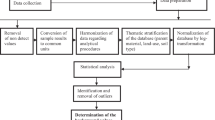Abstract
Beryllium and aluminium contents in uncontaminated soils from six countries are reported. The means and ranges of beryllium in the surface soils were as follows: 1.43(0.20–5.50)μg g−1 in Thailand (n=28), 0.7 (0.31–1.03) μg g−1 in Indonesia (n=12), 0.99(0.82–1.32) μg g−1 in New Zealand (n=3), 0.58(0.08-1.68)μg g−1 in Brazil (n=16), 3.52(2.49–4.97)μg g−1 in the former Yugoslavia (n=10), and 1.56(1.01–2.73) μg g−1 in the former USSR (n=8). The mean and range of beryllium contents of the surface soils in Japan (1.17(0.27–1.95)μg g−1 n=27) are situated within the values of the soils from these countries except for the Yugoslav soils derived from limestones. The mean of the mean beryllium contents of the surface soils in all these countries is 1.42 μg g−1 which will be used as a tentative average content of beryllium in uncontaminated surface soils, except for the soils derived from parent materials high in beryllium content. The beryllium contents of the subsoils were higher than those of the surface soils in New Zealand and Yugoslavia as is the case with Japan. The correlation coefficient between the contents of beryllium and aluminium in all the soil samples (n=113) including surface soils and subsoils was 0.505 (p < 0.001).
Similar content being viewed by others
References
Anderson,M.A., Bertsch,P.M. and Miller,W.P. 1990. Beryllium in selected southeastern soils. J. Environ. Qual., 19, 347–348.
Asami, T. 1975. Determination of total beryllium in soils by atomic absorption spectrophotometry. J.Sci. Soil Manure, Jpn, 46, 421–424(in Japanese).
Asami, T. 1988. Environmental pollution by beryllium in Japan. In: Wolf, K., van den Brink, W.J. and Colon, F.J. (eds), Contaminated Soils '88, Vol. 1, pp.261–263, Kluwer Academic Publ., Dordrecht.
Asami, T. and Fukazawa,F. 1980a. Determination of beryllium in plants by atomic absorption spectrophotometry. J.Sci Soil Manure, Jpn., 51, 323–327(in Japanese).
Asami, T. and Fukazawa, F. 1980b. Determination of beryllium in water by atomic absorption spectrophotometry. J.Sci. Soil Manure, Jpn., 51, 345–347(in Japanese).
Asami, T. Fukazawa F. 1981a. Beryllium pollution of soils surrounding beryllium factories. Sci. Soil Manure, Jpn., 52, 1–7(in Japanese).
Asami,T. and Fukazawa,F. 1981b. Beryllium pollution of plants surrounding beryllium factories. J. Sci. Soil Manure, Jpn., 52, 8–10(in Japanese).
Asami,T. and Fukazawa,F. 1985. Beryllium contents of uncontaminated soils and sediments in Japan. Soil Sci. Plant Nutr., 31, 43–53.
Bowen,H.J.M. 1979. Environmental Chemistry of the Elements. p.60. Academic Press, London, New York, Toronto, Sydney, San Francisco.
Conner,J.J. and Shacklette,H.T. 1975. Background Geochemistry of Some Rocks, Soils, Plants, and Vegetables in the Counterminous United States. Geological Survey Professional Paper 574-F, pp.33–35.
Dudka, S. and Markert, B. 1992. Baseline concentrations of As, Ba, Be, Li, Nb, Sr and V in surface soils of Poland. Sci. Total Environ., 122, 279–290.
Everest,D.A. 1964. The Chemistry of Beryllium. p.151. Elsevier, Amsterdam.
Glazovskaya,M.A.(Editor-in-Chief),1974. Guide to Soil Excursion, The East-European Plain. Forest-Steppe and Steppe Zones, Tour 1. p.86. Nauka, Moscow.
Gorham,E. and Swaine,D.J. 1965. The Influence of oxidizing and reducing conditions upon the distribution of some elements in lake sediments. Limnol. Oceanogr., 10, 268–279.
Kabata-Pendias,A. and Pendias,H. 1992. Trace Elements in Soils and Plants, 2nd edn, p.113. CRC Press, Boca Raton, Ann Arbor, London.
Meehan, W.R. and Smythe, L.E. 1967. Occurrence of beryllium as a trace element in environmental materials. Environ. Sci. Technol., 1, 839–844.
Sato,A. 1981. Practice on Furnace Atomic Absorption Spectrometry. pp.79–81. Kodansha, Tokyo(in Japanese).
Swaine,D.J. 1955. The Trace Element Content of Soils. p.19. Commonwealth Agricultural Bureau, Farnham.
Ure,A.M. and Bacon,J.R. 1978. Comprehensive analysis of soils and rocks by spark source mass spectrometry. Analyst, 103, 807–822.
Ure,A.M., Bacon,J.R., Berrow,M.L. and Watt, J.J. 1979. The total trace element content of some Scottish soils by spark source mass spectrometry. Geoderma, 22, 1–23.
Urushibara,K. and Kojima,M. 1974, Soil of the Karst region and its genetic conditions.— About the Adriatic coastal region of Yugoslavia, Akiyoshidai, and Hiraodai in Japan. Pedologist, 18, 95–105 (in Japanese, with English abstract).
Vinogradov,A.P. 1959. The Geochemistry of Rare and Dispersed Chemical Elements in Soils, 2nd edn, p.173. Consultants Bureau, Inc., New York.
Author information
Authors and Affiliations
Rights and permissions
About this article
Cite this article
Asami, T., Kubota, M. Background levels of soil beryllium in several countries. Environ Geochem Health 17, 32–38 (1995). https://doi.org/10.1007/BF00188630
Received:
Accepted:
Issue Date:
DOI: https://doi.org/10.1007/BF00188630




